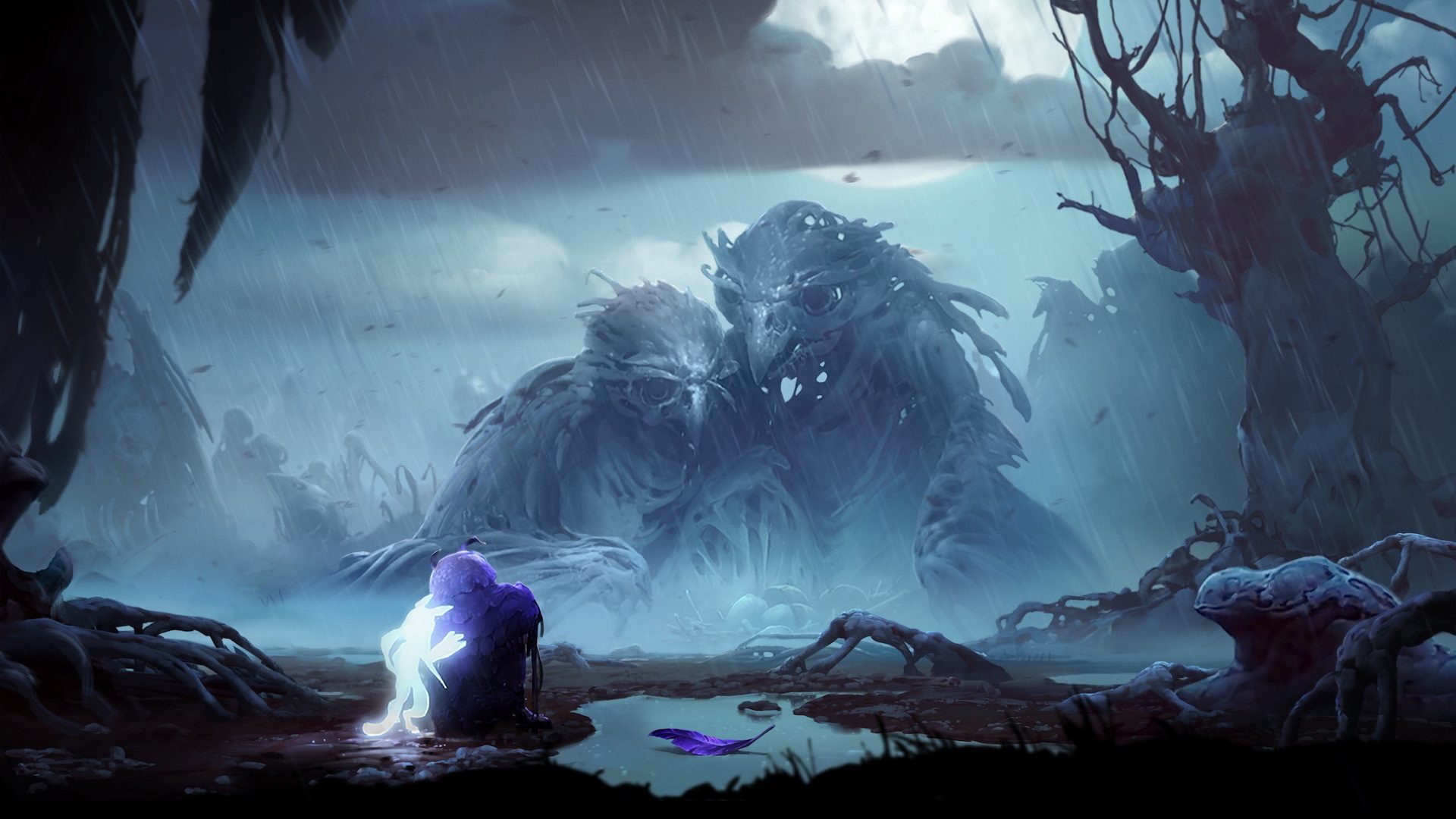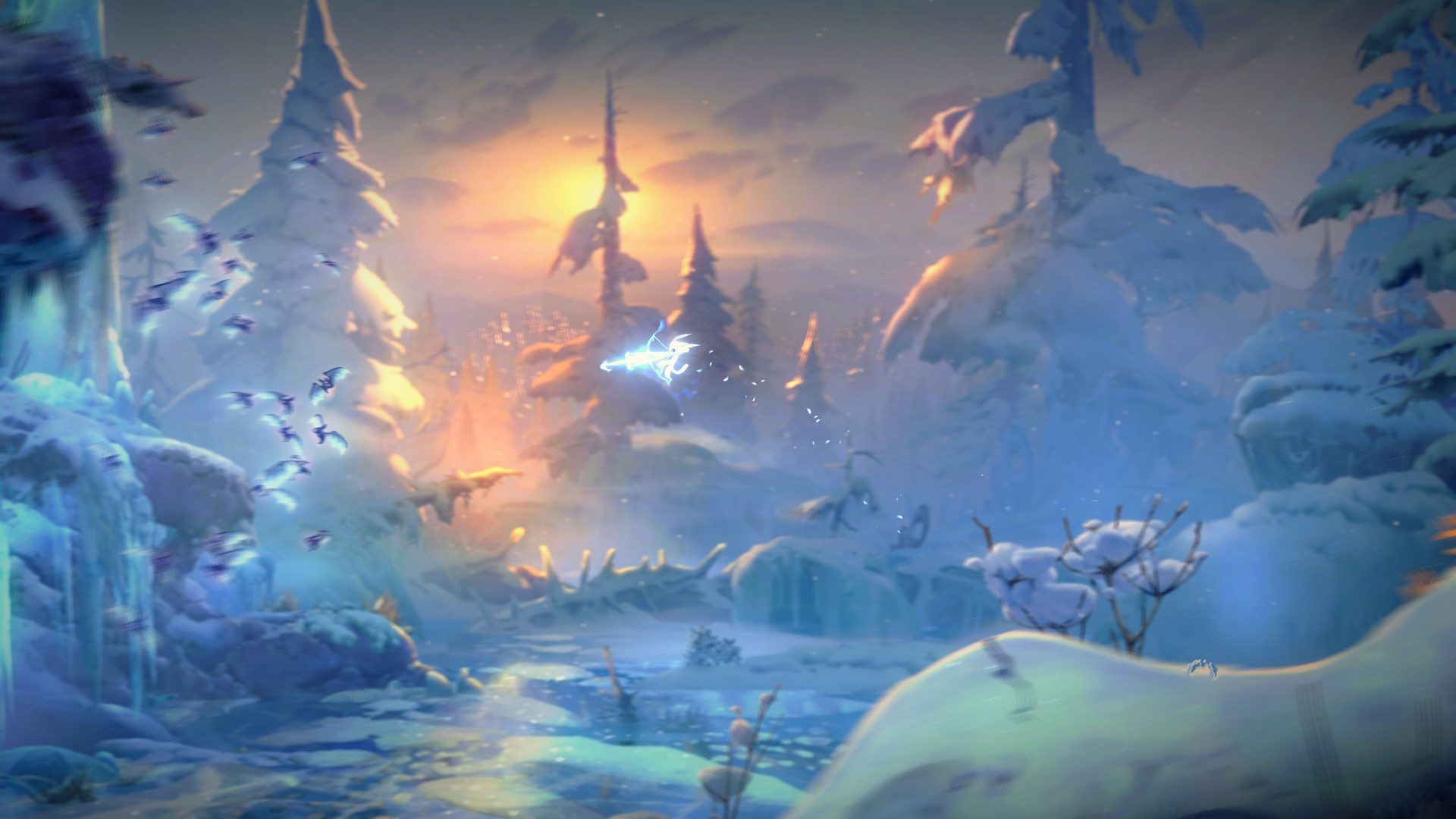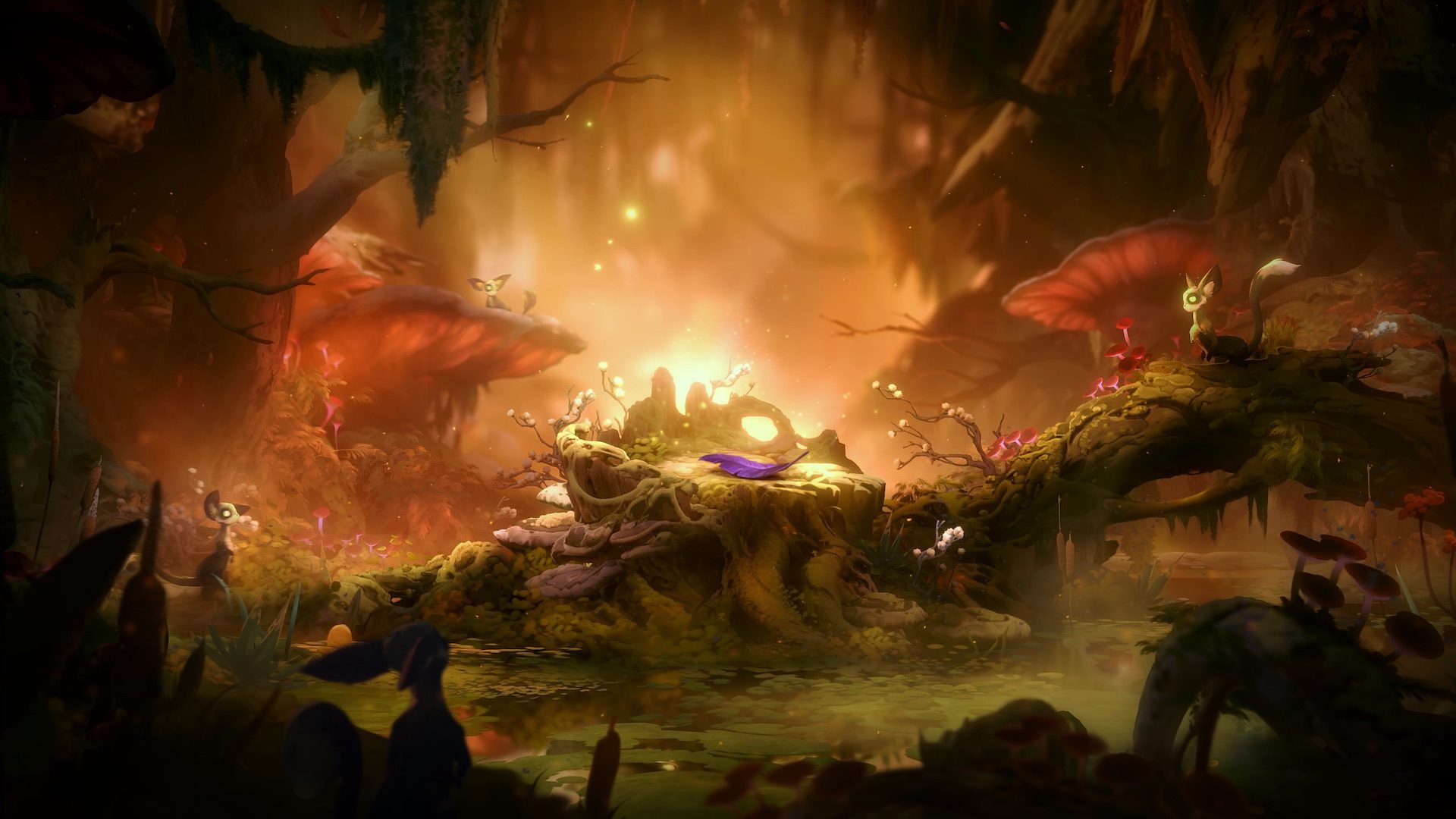There are two separate, overworked, de facto genres that both Ori and the Blind Forest and its sequel, Ori and the Will of the Wisps, lean on. The most obvious is the “Metroidvania” (yes, I know) subgenre of platformers. But there’s another subgenre of tone that’s incredibly popular with indie developers who want players to “feel things” while jumping over obstacles and killing enemies. It’s the kind of sentimental, self-serious storytelling that started with Braid and continues (granted, with more subtlety) in games like Limbo and Gris (or less subtly in Celeste).
The best emotional platformers are the ones where the mechanics come from the story. Braid is so memorable because of how its time-based platforming fits in with the themes of making mistakes and living with the consequences. Inside’s mind-controlling puzzles make total sense in that game’s particular dystopia. It’s when the mechanics work towards making the player feel the story and the world of the game more deeply that these kinds of platformers stand out.
Ori and the Will of the Wisps is the Platonic ideal of a sequel: It’s bigger, better, and more beautiful than its predecessor, while retaining and complicating its surprisingly skillful platforming and taking out pretty much everything that sucked. There’s no doubt that it’s a good, fun game. But like The Blind Forest, Will of the Wisps mistakes sentimentality and cutesy aesthetics for profundity. It’s a sequel in a series that’s still at odds with itself.

Will of the Wisps picks up exactly where The Blind Forest left off: Ori, Namu, and Gumo watch as Kuro’s egg hatches a mathematically adorable baby owl named Ku—it’s tiny, has big eyes, and tries (and fails) to fly with its undersized wings. Ever the thoughtful forest sprite, Ori finds one of Kuro’s feathers and gives it to Ku, inspiring the little bird to finally take flight. However, as Ori rides the winds with Ku, a gigantic, bone-covered owl throws them off course and sends them careening towards a new forest that has its own set of darkness-related problems. It’s the kind of setup that requires prior experience with Ori’s world to contextualize the truncated emotionality of the game’s opening minutes. Not knowing who Ori is or why him, Naru, and Gumo adopting Ku has significance will leave you staring blankly at a weird, glowing, rabbit-monkey-thing’s performative parenthood. If you have played The Blind Forest, the parallels of Ori’s adoption in that game and Ku’s in Will of the Wisps create a sense of reprisal and cyclical destiny.
It’s disappointing that developer Moon Studios doesn’t do anything with these themes of resurrection, reincarnation, and reiteration in terms of Will of the Wisps’ gameplay. There are a few moments that place Ori on Ku’s back and let players control the bird, but they only manifest in highly structured, linear passages and are mechanically simple, especially compared to the rest of the game. As much refinement as there is in Will of the Wisps, there’s nothing really transcendental in its gameplay. There’s nothing in the gameplay that deepens the player’s sense of connection with the story or its themes. It just feels like a platformer with cutscenes attached to it.
Part of the reason I’m picking on Will of the Wisps is that it’s so obviously cloying and cloyingly obvious in its intentions. I know exactly what it wants me to feel, and it’s annoying. There’s nothing worse than a story trying to make me sad by having something bad happen to the cute thing. Why it works in something like Death Stranding (at least for me) shows why it doesn’t work in Will of the Wisps: As a player, I want to connect with that thing through gameplay. If I wanted to watch something that’s almost scientifically manufactured to make people cry, I’d watch the first 10 minutes of Up or the last two minutes of the Futurama episode “Jurassic Bark.” Emotional connection in games should be achieved through gameplay, but Will of the Wisps is even more of a solitary experience than The Blind Forest—just a better version.

For fans of the first game, that should be enough. Just like The Blind Forest, Ori and the Will of the Wisps is a Good Sequel to a Good Game, with a bigger map, more refined art and animation, and a few new moves. It improves upon The Blind Forest in every way, especially when it comes to a more customizable experience.
No, you can’t give Ori a hat or make him neon pink, but you can change the way the spritely guardian spirit performs, thanks to the new Shard System. Instead of outright giving Ori certain abilities, Will of the Wisps lets players discover and purchase Shards that grant Ori either passive boosts or active abilities. Moves like being able to cling to walls and the triple jump, for example, are earned as Shards, and you can only equip a certain amount of Shards (with more Shard spaces unlocking if you complete specific combat shrines). If you want an easier go at the often challenging and tricky platforming, the aforementioned wall-climbing and triple-jumping shards are nigh indispensable, but if you want, say, more powerful combat output, you can equip a shard that will make Ori squisher but give him a much higher attack.
Shards are just one excuse to explore Will of the Wisps larger and more diverse map. You can find two different materials—seeds and ore—that will upgrade Will of the Wisps “hub” area and unlock new places to explore and treasures to find. There’s currency hidden everywhere that lets you purchase new optional combat moves, like a spear or a hammer. What’s really interesting about the combat moves is that some are entirely optional, but if you want to 100-percent complete every area, there are a few that you will need to purchase. Fortunately, every enemy you defeat drops currency, so you’ll never not be able to buy whatever you want.
What makes the optional aspects of Will of the Wisps progression system so satisfying is that it lets you make improvisational micro-decisions pretty much every second. This is most obvious in combat: While you can get through the entire game with pretty much just Ori’s standard attack (which you can unequip in favor of other moves that will drain your energy meter), you can also use a bow and arrow, hammer, or an explosive blast that sets enemies on fire. There’s even an especially handy move that lets you spend a small amount of energy to get back a large chunk of your life. Some of the best moves—like the Flash or the Light Burst—are unlocked naturally as the story progresses, but others are entirely optional. Most freeing is how you can swap out these moves on the fly, so if one special attack isn’t working, you can just equip a different one.

Likewise, Will of the Wisps’ platforming gives you a little leeway when it comes to how you approach each challenge. The triple jump not only gives you a safety net, but it can let you be more creative when tackling certain obstacles. A new move that lets you redirect enemy projectiles and give yourself a boost resets your double and triple jumps, as well as your dash move, giving you the opportunity to chain together miraculous acrobatic feats. Some of the new dash moves factor into the level design, and while they don’t necessarily give you more options since using them is often required to get through areas, they definitely open up more level design possibilities for the developer.
The only place where Will of the Wisps’ more open-ended gameplay sort of falls apart is in its boss fights. I almost entirely cheesed the first half of one boss’s health bar by hiding in a corner it couldn’t reach and equipping Flash, which automatically damages enemies within its diameter. Another boss was made trivially easy by the fact that hitting an enemy midair actually resets your jumps, so I stayed in the air for about 90 percent of the fight, smacking the boss in the face while his attacks had no chance of hitting me. The only relief he got was from a chase-based platforming segment that triggered when his health bar was half empty. But maybe these situations aren’t accidents; maybe they’re the best showcase for how Will of the Wisps lets players improvise their own solutions.
Performances Issues
It’s important to note that my time with Ori and the Will of the Wisps wasn’t without its performance problems, though Xbox Game Studios has already announced that there is a day-one patch that should fix these issues. Still, without the patch, the game is pretty much unplayable on a standard Xbox One S. The game stutters every 20 seconds, which is especially annoying for such a precision-based platformer. Transitioning between the menus and the game also causes a noticeable delay. The only issue I had when playing on Xbox One X was that, at one point, I was stuck on the main menu screen and couldn’t start the game. I had to uninstall and reinstall, which was annoying but not the end of the world. Like I mentioned, Xbox PR promised that the day-one patch will fix these issues, but it still doesn’t bode well for a future of cross-generational console gaming—especially when the offender is a first-party indie game.
Ori and the Will of the Wisps is a true sequel to The Blind Forest. It’s just better in every way. But it also isn’t as memorable as Moon Studios and Xbox Game Studios would like it to be, and that’s because there’s nothing that really makes the game stand out. I enjoyed playing Will of the Wisps, but I didn’t really care about it. When emotional platformers are a dime a dozen, the ones that find a way to bring the figurative language of the story into the actual mechanics are the ones that stand out. As good as it is, Ori and the Will of the Wisps is already retreating to the back of my mind.
All images: Xbox Game Studios
|
★★★★☆
Ori and the Will of the Wisps does everything that a good sequel is supposed to do. It refines The Blind Forest’s mechanics, expands on the world, and throws in a whole bunch of new moves and concepts. But in an era that’s rich with “emotional platformers,” Will of the Wisps doesn’t do anything to make itself stand out. It’s a fine, if not forgettable, experience. |
Developer Moon Studios Publisher Xbox Game Studios ESRB E - Everyone Release Date 03.11.2020 |
| Ori and the Will of the Wisps is available on Xbox One and PC. Primary version played was for Xbox One X. Product was provided by Xbox Game Studios for the benefit of this coverage. EGM reviews on a scale of one to five stars. | |

Michael Goroff has written and edited for EGM since 2017. You can follow him on Twitter @gogogoroff.